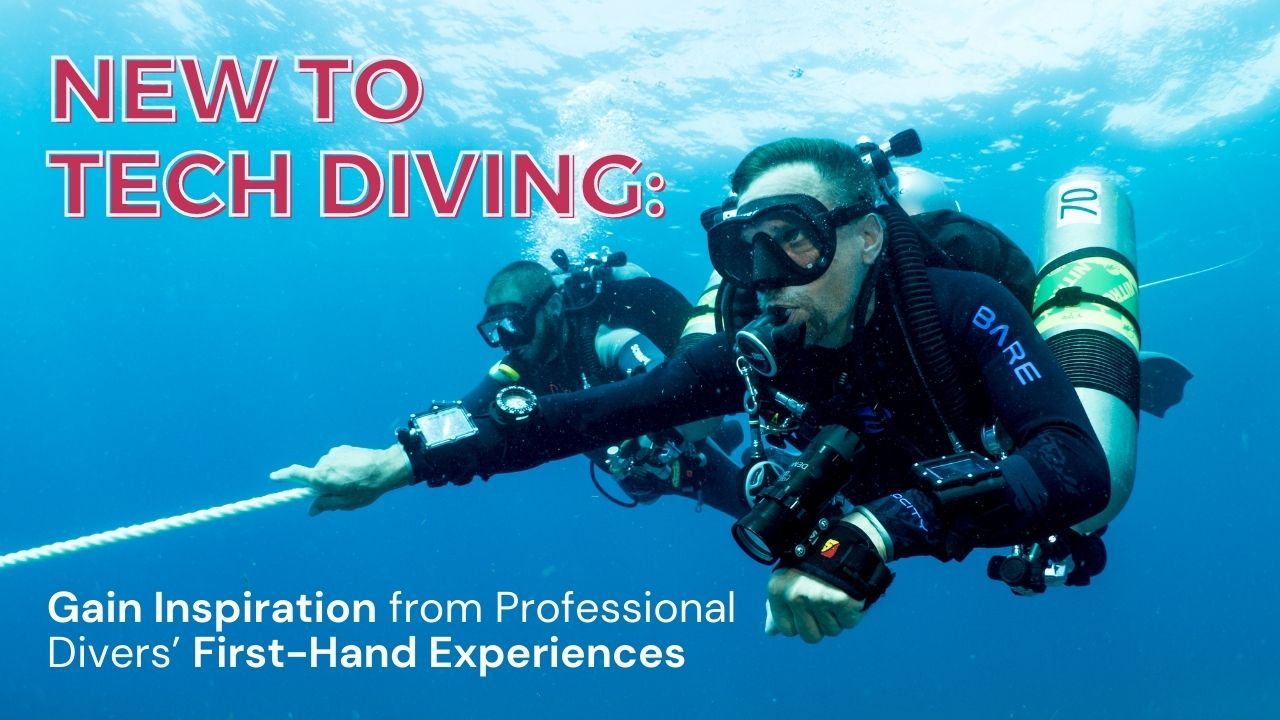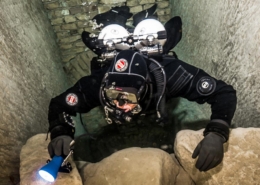New to Tech Diving: Gain Inspiration from Professional Divers’ First-Hand Experiences
By: Nikola Valtosova
When it comes to any activity, hobby or work-related, often the best way to learn is to go straight to the source and ask those with the most experience. That’s why we’ve asked four leaders in the world of technical diving to share their advice and guidance on issues that could benefit both beginners as well as those considering advancing beyond recreational diving. Even professionals can take away something new from their fellow peers, or in the least, compare experiences. From what to do after completing a tech diving course to the struggles or surprises one might encounter when diving to the importance of finding a diving buddy, hear from the pros, themselves, as they answer our questions on these topics and more.
“Gain experience from those who are better than you.”
Following formal training and completion of a diving course, Becky Kagan Schott says it’s important to get as much experience as possible. “Go diving with divers who are better than you to learn from them and find a mentor. Don’t just take classes; keep diving and gaining experience with buoyancy, trim, finning techniques and other skills.” As a tech diving instructor including the Liberty Sidemount rebreather and five-time Emmy award-winning underwater cameraman and photographer whose work has been featured on National Geographic and the Discovery Channel, Becky is certainly one worth listening to.
Becky cautions against getting involved in diving politics and learning from the Internet. It’s better to find a good instructor or a good dive group to be with. Regarding the technical aspect of diving and necessary equipment, she advises, “Do not buy a jacket buoyancy compensator,” she says, “look into a backplate and wing system. It’s more comfortable, streamlined and will grow with you. Always do your research. Sometimes what a shop recommends isn’t the best for where your diving is headed.”
When it comes to meeting people and making friends, Becky’s advice is simple yet effective: “Joining a diving trip is a great way to meet like-minded divers; even if you’re alone, you’d be surprised how many people sign up for trips themselves.”
If considering becoming a tech diver, Becky comments that it “requires more planning, training and equipment. It also requires the proper mindset. Sport diving can be warm or tropical or using a single tank, whereas technical diving requires more gear to safely visit more extreme environments.” For Becky, personally, it was important to learn how to dive in cold waters. Over time, she learned and practiced how to dress for cold water including using the proper drygloves. As for her other gear, Becky considers her mask to be one of the most important instruments: “If I can’t see where I’m diving and it’s not comfortable then why am I even there?”.
“Most important piece of equipment? A positive mindset and a healthy body.”
Concerning the discussion about technical versus sport diving, Pim Van Der Horst, instructor trainer, teacher and author who made headlines in 2008 for his world-record dive to a depth of 236
meters, says “A technical diver spends money on his own equipment and is diving on a regular basis. Sport divers are more open to rental equipment. There is a gray area: sport divers with their own equipment who are diving every week but stay away from decompression limits. This group of divers is more open to technical diving.”
As mentioned, the importance of finding friends and joining a community cannot be stressed enough. According to Pim, “there are now many (technical) diving communities.” You can pick one based on the following criteria: training agency (e.g. TDI), location, underwater activities (e.g. photography), type of diving, equipment (e.g. rebreather, DPV, cameras), manufacturer (e. g. Divesoft), etc. The best way to start is with your agency which provides a good base for finding additional communities.
Since Pim was one of the first rebreather divers, the early days proved to be a challenge: rebreathers were refused on (diving) boats and they were hard to buy (in some places even forbidden – such as France!). Luckily, this has changed and nowadays, rebreathers are a widely-used piece of diving equipment. When it comes to Pim’s most important insight, however, he shares this: “a clear head with a positive mindset and a healthy body”.
Pim also encourages future divers to ask themselves important questions before fully committing to becoming a tech diver: “Is it about the C-card or is it about experiencing new challenges? For whom are you doing it? For an audience or for yourself? Do you have the time, money and support from your family?”
“I just never gave up. I continued to push to prove myself.”
Marissa Eckert, diving instructor, photographer and co-owner of the Hidden Worlds Diving Shop in Fort White, Florida, considers finding the right buddy essential: “It’s extremely important to find a like- minded buddy”, she says. “It’s important to have someone you mesh well with, who has the same principles and the same attitude towards diving. If you are with someone who is very different from you, you may find yourself in some very uncomfortable situations. It’s okay to be different, different is good, and having a buddy who helps you grow and learn is great, but you don’t want someone to push you to do dangerous things.”
When asked about the struggles she had to face, she answers: “Being a woman – it made being taken seriously more difficult. But I just never gave up. I continued to push and push to prove myself.” Furthermore, she adds that she was surprised by how male-dominated the field is and how much inequality still exists.
Marissa also believes the perceived dichotomy of sport and technical divers to be false, stating that “You are not necessarily only one or the other. Sometimes I am a sport diver, sometimes I am a technical diver. It’s more about the type of dive you are doing at the time. Does it involve technical equipment? Like a dual configuration, for example. Are you going into decompression? Penetrating into a wreck or a cave? Then you are a technical diver. If I am staying within my no decompression limits and am in a single tank in open water, I am a sport diver.”
For Marissa, her most indispensable piece of equipment is her rebreather, particularly the CCR Liberty, her main sidemount unit, saying: “It’s opened so many doors to me. From getting up close and personal to sharks in Cocos Islands to going deep inside caves I’d otherwise never get to see!”.
And what is the best piece of diving advice she’s ever received? It has to do with mutual understanding and kindness: “Anyone can turn the dive at any time for any reason and no one should ever challenge the decision. And if they do, never dive with them again.”
“Base your training on quality, not speed or cost.”
Edd Stockdale is the head of the Finnish Scientific Diving Academy. He teaches technical courses around the globe, participates in research expeditions, and stresses the importance of finding the right buddy to dive with. For him, a key aspect is having someone you can trust in an emergency. How do you achieve this? “This is driven by good communication, similar drive and experience. Diving is always more enjoyable when you don’t have to worry where your team is or if they know where you are.” When looking for like-minded people, Edd says that it’s important not to limit yourself within a specific clique or group, but rather to expand your training and horizons. Echoing Becky Kagan Shott’s statements, he says that “Local dive clubs are also an option in many places but are, sadly, often overcome with politics and ego.”
When starting out, Edd advises beginners to dive in places they are familiar and comfortable with, similar to the conditions they trained in. The training should definitely be based on quality rather than the speed or cost: this will save you money and time in the long run.
Edd cannot imagine doing technical diving without suitable fins. He says “you cannot do advanced diving with ill-suited propulsion, so you need the correct fins for the job. This can vary slightly depending on the environment but in general, get the basic fin (often rubber) that fits well with a spring strap system.” On the other hand, he advises saving money and getting just one trimix computer, as a second is not required for an entry level decompression program; a bottom timer can do the same job with the correct training, meaning that money could be invested in other required items (i.e. proper exposure protection, regulators, wing system, a good SMB, etc.)
In summary, here are five takeaways from the professionals:
- Do not underestimate the importance of finding a like-minded buddy.
- Invest time and money into your training; it will pay off in the long run.
- Get comfortable with your gear and equipment.
- Join a community, whether it is based on the location, underwater activities, training agency, etc. and don’t involve politics in such a beautiful sport.
There is not always a clear line between technical and sportdiving: people’s views may vastly differ.









 Natalie L. Gibb
Natalie L. Gibb
Skriv en kommentar
Vil du deltage i diskussionen ?Du er velkommen til at bidrage !